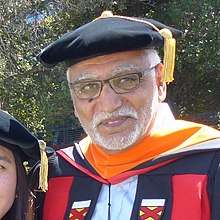Abbas El Gamal
Abbas El Gamal (born May 30, 1950) is an Egyptian-American electrical engineer, educator and entrepreneur. He is best known for his contributions to network information theory, field-programmable gate arrays (FPGAs), and CMOS imaging sensors and systems.[1][2] He is the Hitachi America Professor of Engineering at Stanford University. He has founded, co-founded and served on the board of directors and technical advisory boards of several semiconductor, EDA, and biotechnology startup companies.[3]
Abbas El Gamal | |
|---|---|
 | |
| Born | 1950 (age 69–70) Cairo, Egypt |
| Nationality | American |
| Alma mater | Cairo University; Stanford University |
| Known for | Network information theory, FPGA, digital imaging devices and systems |
| Awards | 2016 IEEE Hamming Medal, 2012 Shannon Award, Member of the NAE, IEEE Life Fellow |
| Scientific career | |
| Fields | Electrical engineering, information theory, integrated circuits |
| Thesis | Results in Multi-user Information Theory |
| Doctoral advisor | Thomas Cover |
Biography
He was born on May 30, 1950, in Cairo, Egypt.
Education
El Gamal received his B.Sc. Honors degree from Cairo University in 1972. From Stanford, he earned an M.S. in electrical engineering in 1975, an M.S. in statistics in 1977 and his Ph.D. in 1978.
Academic career
El Gamal was an assistant professor in the Department of Electrical Engineering from 1978 to 1980. He has been on the faculty of the Department of Electrical Engineering since 1981. He was director of the Information Systems Laboratory from 2004 to 2009. From 2012 to 2017 he was chair of the Department of Electrical Engineering at Stanford University.[4]
In his primary field, network information theory, El Gamal studies the absolute performance limits of communication and computing networks and develops algorithms and protocols to achieve these limits. He published highly cited papers on several classical problems in the field and co-authored its first textbook, Network Information Theory.
Likewise, he was a pioneer in the development of Field Programmable Gate Arrays (FPGA)—a type of integrated circuit that can be electrically reconfigured to implement differing functions. He holds key patents and wrote several highly cited papers on basic architecture and design of FPGAs and pioneered the use of FPGAs in teaching digital system design.
El Gamal was also a key figure in the development of CMOS image sensors, the technology widely used today in cell phone and digital cameras. He started the industrially funded Programmable Digital Camera project, which helped spur several key innovations in the field and funded several PhD students who became leaders in the image sensor industry and research. He also developed an award-winning course on the topic.[5]
Business
In 1984, El Gamal joined LSI as director of its newly formed Systems Research Laboratory, which evolved into the company's very successful Consumer Product Division.
In 1986 he cofounded Actel – only the second FPGA company in the world – where he made several key inventions in FPGA architecture and held multiple posts, including that of chief scientist until 1990. Actel was acquired by Microsemi in 2010.
In 1990, he founded Silicon Architects – one of the first silicon IP companies in the world – holding multiple posts, including that of chief technical officer until its acquisition by Synopsys in 1995, where he was a vice president until 1997.[6][7]
In 1998, El Gamal co-founded Pixim, Inc., a fabless semiconductor company that developed chipsets for security cameras based on the Digital Pixel Sensor technology developed by his group at Stanford. Sony Electronics acquired Pixim in 2012.[8]
In 2011, El Gamal co-founded Inscopix, a neurotech company developing tools to enable monitoring of brain activity in vivo. He serves on its board of directors.[9]
He served on the board of directors of Numerical Technologies, which developed software tools for the design and manufacturing of subwavelength integrated circuit fabrication. The company was acquired by Synopsys. He also served on the board of directors of Berkeley Design Automation, which developed tools for analog, mixed-signal, RF, and custom digital verification.[10] The company was acquired by Mentor Graphics in 2014.[11] He also served on the technical advisory board of several other Silicon Valley companies, including Ion Torrent Systems, which developed miniaturized DNA sequencing platforms and was later acquired by Life Technologies.
Awards and Honors
* 2016 IEEE Richard W. Hamming Medal
* 2014 Viterbi Lecture, University of Southern California
* 2013 Shannon Memorial Lecture, UCSD
* 2013 Member of the National Academy of Engineering
* 2012 Claude E. Shannon Award, IEEE Information Theory Society
* 2000 Fellow, Institute of Electrical and Electronic Engineers
Bibliography
Books
Network Information Theory, (Cambridge University Press, 2011) – with Young-Han Kim
Journals
2011: "Miniaturized integration of a fluorescence microscope," Nature Methods – with K. Ghosh, L. Burns, E. Cocker, A. Nimmerjahn, Y. Ziv, M. Schnitzer
2006: "Throughput-Delay Trade-offs in Wireless Networks," in two parts, IEEE Trans. Inf. Theory – with J. Mammen, B. Prabhakar, and D. Shah
2002: "Energy-efficient Packet Transmission over a Wireless Link," IEEE/ACM Transactions on Networking –with E. Uysal-Biyikoglu and B. Prabhakar
2001: "A 10,000 Frames/s CMOS Digital Pixel Sensor," IEEE Journal of Solid-State Circuits – with S. Kleinfelder, S. Lim, X. Liu
1982: Achievable rates for multiple descriptions – with T. Cover
1979: Capacity theorems for the relay channel – with T. Cover
References
- "Abbas El Gamal – Information Theory Society". www.itsoc.org. Retrieved 2018-07-24.
- "Abbas El Gamal | Simons Institute for the Theory of Computing". simons.berkeley.edu. Retrieved 2018-07-24.
- Bloomberg https://www.bloomberg.com/research/stocks/private/person.asp?personId=540925&privcapId=12719521
- "Abbas El Gamal". isl.stanford.edu. Retrieved 2018-07-24.
- "Abbas El Gamal named Chair of Department of Electrical Engineering". Stanford School of Engineering. 2016-06-09. Retrieved 2018-07-24.
- "Company Overview of Silicon Architects". Bloomberg.
- "Strategic Acquisitions". Synopsys.
- "Pixim". crunchbase.
- "Inscopix Leadership". Inscopix.
- "Berkeley Design Automation". crunchbase.
- "MentorMentor Graphics Acquires Berkeley Design Automation to Advance Nanometer Analog/Mixed-Signal Verification". Mentor.